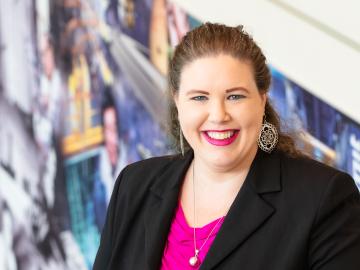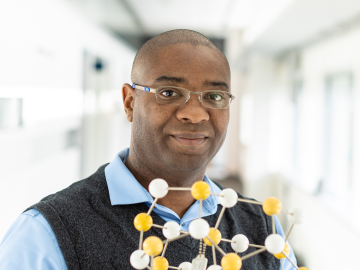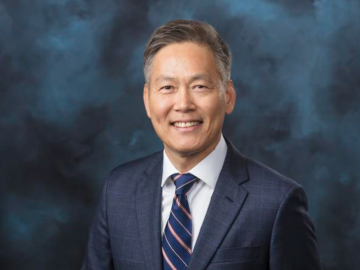
Filter News
Area of Research
- Advanced Manufacturing (9)
- Biology and Environment (22)
- Clean Energy (52)
- Computational Biology (1)
- Computational Engineering (2)
- Computer Science (2)
- Energy Frontier Research Centers (1)
- Fusion and Fission (5)
- Fusion Energy (2)
- Isotope Development and Production (1)
- Isotopes (10)
- Materials (109)
- Materials Characterization (2)
- Materials for Computing (18)
- Materials Under Extremes (1)
- Mathematics (1)
- National Security (17)
- Neutron Science (30)
- Nuclear Science and Technology (4)
- Quantum information Science (2)
- Supercomputing (32)
- Transportation Systems (1)
News Type
News Topics
- (-) Biomedical (28)
- (-) Clean Water (15)
- (-) Cybersecurity (20)
- (-) Isotopes (23)
- (-) Materials (93)
- (-) Materials Science (85)
- (-) Nanotechnology (38)
- (-) National Security (21)
- 3-D Printing/Advanced Manufacturing (74)
- Advanced Reactors (23)
- Artificial Intelligence (45)
- Big Data (24)
- Bioenergy (39)
- Biology (39)
- Biotechnology (10)
- Buildings (34)
- Chemical Sciences (41)
- Climate Change (45)
- Composites (19)
- Computer Science (99)
- Coronavirus (28)
- Critical Materials (23)
- Decarbonization (29)
- Education (3)
- Element Discovery (1)
- Energy Storage (74)
- Environment (79)
- Exascale Computing (11)
- Fossil Energy (2)
- Frontier (16)
- Fusion (24)
- Grid (36)
- High-Performance Computing (40)
- Hydropower (6)
- Irradiation (2)
- ITER (5)
- Machine Learning (25)
- Mathematics (2)
- Mercury (5)
- Microelectronics (1)
- Microscopy (27)
- Molten Salt (8)
- Net Zero (5)
- Neutron Science (77)
- Nuclear Energy (46)
- Partnerships (30)
- Physics (28)
- Polymers (21)
- Quantum Computing (14)
- Quantum Science (37)
- Renewable Energy (1)
- Security (12)
- Simulation (15)
- Space Exploration (13)
- Statistics (2)
- Summit (27)
- Sustainable Energy (75)
- Transformational Challenge Reactor (4)
- Transportation (60)
Media Contacts

ORNL’s electromagnetic isotope separator, or EMIS, made history in 2018 when it produced 500 milligrams of the rare isotope ruthenium-96, unavailable anywhere else in the world.

Anne Campbell, an R&D associate at ORNL, has been selected for an Emerging Professional award from ASTM International. ASTM, formerly the American Society for Testing and Materials, is an international standards organization that develops and publishes voluntary consensus technical standards for a wide range of materials, products, systems and services.

Valentino “Tino” Cooper, a scientist at ORNL, has been appointed to DOE’s Basic Energy Sciences Advisory Committee for a three-year term. Cooper’s research elucidates the fundamental understanding of advanced materials for next-generation energy and information technologies.

Andrew Lupini, a scientist and inventor at ORNL, has been elected Fellow of the Microscopy Society of America.

Marm Dixit, a Weinberg Distinguished Staff Fellow at ORNL has received the 2023 Rosalind Franklin Young Investigator Award.

Ho Nyung Lee, a condensed matter physicist at the Department of Energy’s Oak Ridge National Laboratory, has been elected a Fellow of the Materials Research Society.

A technology developed at ORNL and used by the U.S. Naval Information Warfare Systems Command, or NAVWAR, to test the capabilities of commercial security tools has been licensed to cybersecurity firm Penguin Mustache to create its Evasive.ai platform. The company was founded by the technology’s creator, former ORNL scientist Jared M. Smith, and his business partner, entrepreneur Brandon Bruce.

ORNL has entered a strategic research partnership with the United Kingdom Atomic Energy Authority, or UKAEA, to investigate how different types of materials behave under the influence of high-energy neutron sources. The $4 million project is part of UKAEA's roadmap program, which aims to produce electricity from fusion.

Warming a crystal of the mineral fresnoite, ORNL scientists discovered that excitations called phasons carried heat three times farther and faster than phonons, the excitations that usually carry heat through a material.

Researchers from Yale University and ORNL collaborated on neutron scattering experiments to study hydrogen atom locations and their effects on iron in a compound similar to those commonly used in industrial catalysts.


